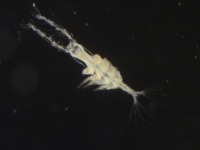
(Photo: Huntsman Marine Science Centre)
Monstrilloid Copepod
Monstrilla sp.
A small, translucent, brown copepod. From the top, the head looks squared off. From the side, it appears to be very rounded. It has thick, straight antennules. The adults have no mouthparts. Adults are one to four millimetres in length. The parasitic life stage may appear as nodules on molluscs.
Authority
Isaac, 1974
Classification Details
Phylum: Arthropoda (arthropods); Subphylum: Crustacea (crustaceans); Subclass: Copepoda (copepods).
Habitat
The northeast Atlantic region has 32 species. They are parasites of marine invertebrates during the juvenile stages. The copepodite and adults are free-swimming.
Diet
Adults do not feed. Juveniles are parasites on worms or molluscs. The developing copepod uses root-like vessels to absorb nutrients from its host.
Reproduction
Sexes are separate. The nauplius attaches to a polychaete worm or mollusc host, burrows inside, and develops within the host. During the final juvenile stage, the copepod leaves the host through the body wall and moults to become an adult.
Fun Facts
Adults don't eat; they don't have any mouthparts. Their only goal is reproduction.
This species can be a pest to commercial mussel populations because they damage their mollusc hosts.
References
O'Brien T and Ramos S (2019). COPEPEDIA. Monstrilla. https://www.st.nmfs.noaa.gov/nauplius/media/copepedia/taxa/T4000435/ Accessed online 22 January 2020. Suárez–Morales E (2011) Diversity of the Monstrilloida (Crustacea: Copepoda). PLoS ONE 6(8), e22915. doi:10.1371/journal.pone.0022915 Walter TC and Boxshall G (2020) World of Copepods database. Monstrilla Dana, 1849. Accessed through: World Register of Marine Species at: http://www.marinespecies.org/aphia.php?p=taxdetails&id=119780 Accessed online 22 January 2020.

